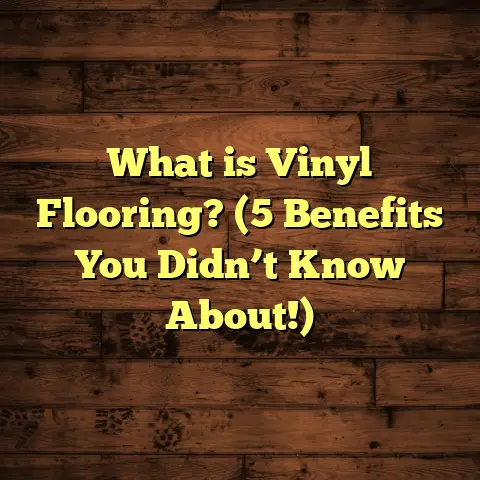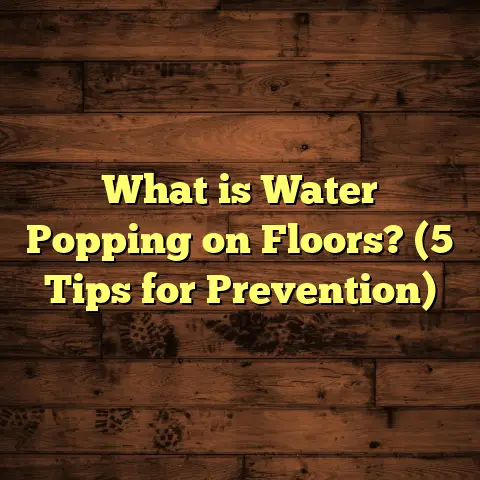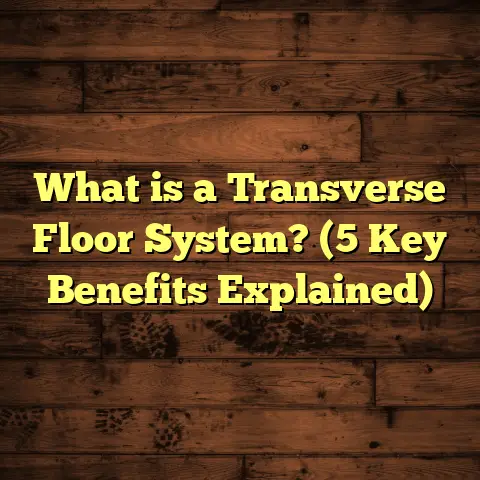What Is Flooring Substrate? (5 Essential Facts for Renovators)
What Is Flooring Substrate?
If you’ve ever worked on a flooring project or even just thought about replacing your floors, you might focus mostly on the finish—the hardwood planks, the sleek tiles, or the soft carpet. But what about what’s beneath all that? The substrate. It’s the unsung hero of your flooring system, and honestly, it’s one of the most important parts you should pay attention to.
I’ve been in the flooring business for years, and trust me, substrate problems can turn a beautiful floor into a nightmare. The substrate is the layer right under your flooring material, the foundation that supports everything. Without a solid substrate, even the most expensive floors can warp, crack, or fail early.
Let me walk you through everything you need to know about flooring substrates—from what they are and why they matter to how you can spot and fix problems. I’ll also share some real-world stories from my experience on job sites that really highlight why substrate is worth your attention.
What Exactly Is Flooring Substrate?
Put simply: the substrate is the surface beneath your finished flooring. It’s the “base” that holds everything together. This layer can be plywood, concrete, oriented strand board (OSB), cement backer board, or other materials depending on where you live and what kind of floor you’re installing.
Think of it like this. Imagine trying to build a house on loose sand versus on top of solid rock. The same principle applies to floors. If the base isn’t firm and even, the floor above will suffer.
Your substrate provides structural support, levels out imperfections in the subfloor or foundation below it, controls moisture transfer from below, and sometimes adds sound insulation or cushioning.
Here’s a quick breakdown of common substrates:
- Concrete slab: Often used in basements or ground floors.
- Plywood: Standard in wood-frame homes.
- Oriented Strand Board (OSB): A budget-friendly alternative to plywood.
- Cement Backer Board: Mostly used under tile in wet areas.
- Underlayments: These can be foam, cork, or rubber layers added on top of other substrates for cushioning or moisture protection.
Without a proper substrate, your floor might squeak, warp, crack, or feel uneven underfoot. In my early days as a contractor, I learned this the hard way when a client’s luxury vinyl floor started buckling within months because I hadn’t leveled their plywood substrate properly.
Why Do Flooring Substrates Matter So Much?
You might think: “Can’t I just put flooring down on any flat surface?” The truth is no. The substrate plays several critical roles that affect your floor’s performance and lifespan.
1. Structural Support
Your flooring needs a strong base to hold it up. If the substrate flexes or moves too much, your floor can crack or buckle. This is especially true for hardwood and tile floors which are less forgiving than carpet or vinyl.
2. Moisture Barrier
Moisture is one of the biggest enemies of flooring. Substrates like concrete often absorb moisture from the ground. Without proper barriers or moisture-resistant substrates, this moisture can travel up and damage wood floors or cause mold under carpets.
3. Level Surface
Even small uneven spots can cause tiles to crack or laminate floors to separate. The substrate smooths out imperfections from the subfloor or foundation below so your finish layer lays perfectly flat.
4. Sound Insulation
Certain substrates include padding or soundproofing qualities that reduce noise transfer between floors—great if you have an upstairs neighbor or a busy household.
5. Longevity
A well-prepared substrate extends your floor’s life by preventing many common issues like warping, cracking, and squeaking.
I was shocked when I discovered a report from the National Wood Flooring Association stating that up to 70% of flooring failures come from problems with the subfloor or substrate—not the finished flooring itself.
Different Types of Flooring Substrates and Their Uses
Let me explain the pros and cons of common substrates so you can see which might be best for your project.
Concrete Slabs
Concrete slabs are extremely durable and common in basements, garages, and ground floors. But concrete is porous and absorbs moisture from the earth beneath it.
In one job I did in a damp basement, we installed engineered hardwood over concrete. We first tested moisture levels with a meter and found them too high for direct installation. So we laid down a liquid-applied moisture barrier and a cushioning underlayment before installing the wood floor. This prevented warping and mold growth later on.
Concrete also tends to be very hard and cold underfoot. Some people like radiant heating embedded in concrete slabs to combat this chill.
Plywood
Plywood is probably the most familiar substrate in residential buildings with wood framing. It’s made by layering thin sheets of wood veneer with glued grains alternating directions for strength.
Plywood is great because it’s strong yet flexible enough not to crack easily under pressure. It’s also relatively easy to work with when leveling or repairing.
I remember a job where plywood was water damaged due to a roof leak that went unnoticed. The floor started squeaking badly after hardwood installation. Replacing affected plywood sheets solved the problem completely.
Oriented Strand Board (OSB)
OSB is made by compressing wood strands with adhesives into panels. It’s cheaper than plywood but less resistant to moisture damage.
I had a client who wanted OSB subflooring for their laminate installation in a humid climate. After testing moisture levels and assessing risk, we recommended switching to plywood for better durability—good call because laminate floors don’t tolerate moisture well.
Cement Backer Boards
These are fiber cement panels designed specifically as tile substrates in wet areas like bathrooms and kitchens. They don’t swell with water and provide an excellent bonding surface for tile adhesives.
On one bathroom remodel, using cement backer board prevented cracks in tile that had happened previously when tile was installed directly over plywood.
Underlayment Layers
Underlayments are thin layers added on top of substrates for cushioning, soundproofing, or moisture protection. Materials include foam, cork, rubber, felt paper, or specialized synthetic sheets.
For example, laminate floors almost always require foam underlayment to improve comfort and reduce noise.
How to Tell If Your Substrate Is Ready for Flooring?
Before installing any floor, it’s smart to inspect the substrate carefully to avoid problems down the road. Ask yourself:
- Is it level? Even small bumps can cause issues.
- Is it clean? Dust or debris hurts adhesion.
- Is it dry? Moisture content should be within limits.
- Is it stable? No loose panels or weak spots.
- Are there cracks or damage?
Tools like spirit levels, straight edges, and moisture meters help measure these factors precisely.
I carry a moisture meter on every job because moisture problems can be invisible but devastating. Once, on a kitchen renovation over concrete slab, I measured moisture at 18%—way too high for vinyl plank installation without a barrier. We installed a vapor barrier before proceeding.
Preparing Your Substrate: Steps for Success
If your substrate isn’t perfect (and most aren’t), preparation is key:
- Cleaning: Sweep and vacuum thoroughly.
- Leveling: Use patch compounds or sanding to fix dips and bumps.
- Moisture Barriers: Install vapor barriers on concrete slabs if needed.
- Underlayment: Add foam or cork layers depending on flooring type.
- Repair: Replace damaged sections or reinforce weak spots.
On one project where I installed hardwood over concrete, we used a self-leveling compound to smooth out minor cracks and unevenness. That step took extra time but prevented squeaks and gaps from forming later.
Matching Substrate Types with Flooring Materials
Different flooring materials require certain substrates for best results:
| Flooring Type | Recommended Substrate | Typical Prep Steps |
|---|---|---|
| Hardwood | Plywood (3/4 inch) | Leveling; moisture check; underlayment optional |
| Laminate | Plywood or OSB | Foam underlayment; level surface |
| Vinyl Planks | Concrete slab or plywood | Moisture barrier often needed; flat surface |
| Ceramic Tile | Cement backer board over plywood/concrete | Clean & level; no flex allowed |
| Carpet | Plywood or concrete | Padding; less strict level requirements |
Ignoring these recommendations often leads to premature wear or installation failures—something I’ve had to fix more than once!
Interesting Data Points About Flooring Substrates
Here are some stats from industry reports and my own experience:
- 70% of flooring failures trace back to substrate issues (NWFA).
- Moisture-related problems cause nearly 30% of flooring damage claims in humid regions (FloorScore).
- Self-leveling compounds can reduce installation errors by up to 85% when used correctly.
- Proper vapor barriers extend hardwood floor life by 5+ years in high-moisture environments.
- Average cost of substrate prep ranges from $1-$3 per square foot but saves thousands in repairs later.
Keeping these figures in mind helps explain why substrate prep shouldn’t be overlooked—even if it adds upfront cost.
Real Stories From the Field: Lessons Learned About Substrates
Story 1: The Buckling Vinyl Floor
Early in my career, I installed luxury vinyl plank flooring over an old plywood subfloor without checking its flatness carefully. Within six months, parts of the floor started buckling painfully.
When I went back to investigate, I found uneven areas of nearly 1/4 inch that caused pressure points underneath planks. We had to remove several rows and redo the whole thing after leveling properly with a patching compound.
That experience taught me never to skip flatness checks—no matter how small the project looks!
Story 2: Moisture Wrecks Hardwood
A homeowner called me frustrated when their beautiful hardwood floor began cupping after just three months in their basement apartment built over concrete slab.
Moisture testing revealed high humidity seeping through concrete without any vapor barrier installed during construction.
We removed all flooring, installed a liquid-applied moisture barrier plus cork underlayment for cushioning and vapor control before reinstalling engineered hardwood designed for basements.
The floor hasn’t had any issues since—almost five years now.
Story 3: Tile Cracks Fixed with Cement Board
A bathroom tile installation failed repeatedly due to cracks developing after some months. The builder had installed tile directly over plywood subfloor without cement backer board.
We ripped out tiles and plywood sections, installed cement backer board with waterproof membrane underneath before retiling.
The new tiles have held up perfectly ever since—no cracks or loose grout lines years later.
Expert Tips for Renovators About Flooring Substrate
If you’re planning your own flooring project at home (or managing contractors), here are tips I always share:
- Don’t Skimp on Inspection
Spend time checking flatness, moisture levels, and structural soundness before ordering materials. - Use Tools
Invest in or borrow moisture meters and levels—they save headaches later. - Follow Manufacturer Guidelines
Every flooring type has specific substrate requirements—stick to them! - Consider Climate
High humidity means vapor barriers are often necessary; dry climates may allow more flexibility. - Prepare for Extra Cost
Substrate prep adds cost but prevents expensive repairs down the line—budget accordingly. - Hire Professionals When Unsure
If you don’t feel confident assessing substrates yourself, bring in an experienced installer early on.
Common Problems Caused by Poor Substrate Preparation
If substrates aren’t done right, here’s what can happen:
| Problem | Cause | Flooring Types Affected |
|---|---|---|
| Buckling | Uneven subfloor; moisture | Vinyl plank; hardwood |
| Cupping | High moisture content | Hardwood |
| Cracking tiles | Flexing substrate; lack of backer | Ceramic tile |
| Squeaking floors | Loose or damaged plywood | Hardwood; laminate |
| Gaps & separation | Movement due to poor prep | Laminate; hardwood |
Avoiding these issues saves money and frustration later—trust me on this one!
Deep Dive Into Moisture Management Under Floors
Moisture control is perhaps the trickiest part of substrate preparation. Floors hate water intrusion whether they’re wood-based or synthetic.
Here’s what I recommend:
- Always test concrete slabs with a reliable meter before installation.
- Use liquid-applied membranes or polyethylene sheeting as vapor barriers where needed.
- Ensure crawl spaces are ventilated properly if working over dirt floors.
- Avoid installing wood floors directly over concrete without barriers.
- Monitor indoor humidity levels during humid seasons with dehumidifiers if necessary.
One client had recurring mold under carpet because their crawl space was poorly ventilated—it took sealing vents and adding vapor barriers below before issues disappeared.
How Technology Helps With Substrate Assessment Now
Modern tools have made assessing substrates easier than ever:
- Digital Moisture Meters: Provide accurate real-time readings.
- Laser Levels: Help detect subtle unevenness across large areas quickly.
- Thermal Imaging Cameras: Detect hidden moisture pockets behind walls/floors.
- FloorTally Software: Helps estimate costs including prep work based on local rates—very handy when budgeting projects involving substrates.
I use these tools regularly now and wouldn’t dream of doing big jobs without them.
Balancing Cost vs Quality in Substrate Work
I get asked often: “Can I skip some steps to save money?” My answer usually is: “You might save upfront but risk costly repairs later.”
Basic cleaning or patching might seem unnecessary if your subfloor looks okay visually—but many problems hide beneath surface dust.
One client tried low-cost OSB substrate instead of plywood to cut expenses on their laminate install. Two years later they called me back to replace warped sections due to humidity damage—costing double what they saved originally!
Always weigh initial savings against possible future costs from failures due to poor substrate prep.
Environmental Considerations in Choosing Substrates
In recent years, eco-friendly choices have grown popular:
- Some prefer FSC-certified plywood made from sustainably harvested wood.
- Cork underlayments offer natural soundproofing with renewable materials.
- Low-VOC (volatile organic compound) adhesives minimize indoor air pollution.
- Concrete mixes with recycled materials reduce carbon footprint during construction.
I try suggesting these options when clients want greener renovations without sacrificing quality or durability.
My Final Thoughts After Years Handling Flooring Substrates
If there’s one thing I want you to take away from this long chat about substrates—it’s this: never underestimate what lies beneath your floor’s surface. That hidden layer is more than just support; it’s protection, stability, comfort, and longevity all rolled into one.
I’ve seen gorgeous floors ruined by neglecting substrate issues—and also beautiful transformations when substrate prep was done right from day one.
If you’re tackling renovations yourself or hiring pros, make sure substrate inspection and preparation are part of your plan budgeted for upfront—not an afterthought rushed at install time.
Got questions about your specific floor or substrate situation? Ask away—I’m here to help prevent costly mistakes before they happen!





